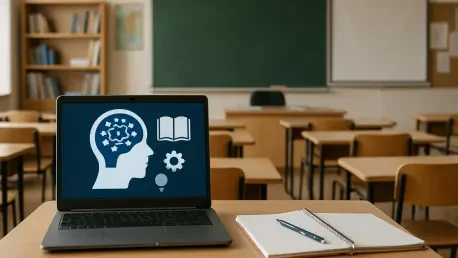Imagine a scenario where a tool designed to transform education could potentially undermine it if not handled with care. Picture a teacher, overwhelmed by endless grading and lesson planning, turning to artificial intelligence for assistance, lured by the promise of slashing hours of work through automated content creation and personalized student support. Yet, beneath this enticing prospect lies a harsh reality: without strict ethical boundaries, AI can produce biased materials, irrelevant lessons, or unfair assessments, potentially harming the very students it aims to help. This dichotomy demands urgent attention as technology reshapes classrooms worldwide.
The Hidden Risks of AI in Learning Spaces
AI’s entry into education offers a glimmer of hope for overburdened educators. Tools powered by algorithms can draft lesson plans in minutes, grade assignments with precision, and even suggest tailored resources for struggling students. However, this efficiency comes with a catch. Unchecked AI systems may prioritize speed over substance, generating content that misses educational goals or embeds subtle biases, such as favoring certain cultural contexts in test questions. This flaw can widen achievement gaps rather than close them, turning a potential asset into a silent liability.
The stakes are evident in real-world scenarios. Consider a school district adopting an AI platform to create math quizzes, only to find questions laced with unfamiliar cultural references that confuse half the class. Such missteps not only frustrate students but also undermine trust in technology as a reliable partner. The challenge lies in balancing AI’s time-saving capabilities with a commitment to quality and equity, ensuring that innovation doesn’t come at the expense of learning integrity.
Why Ethical Boundaries Matter Now
With educators facing packed schedules and diverse student needs, AI’s role as a supportive tool has never been more critical. A recent study from a prominent university revealed a staggering 127 percent improvement in student performance when using customized AI tutors, highlighting the transformative potential of this technology. Yet, as adoption accelerates, so does the urgency to address its pitfalls. Without ethical constraints, AI risks amplifying existing inequities or delivering content that fails to meet pedagogical standards.
The pressure to integrate AI responsibly is compounded by the fast-paced nature of modern education. Teachers often lack the time to scrutinize every AI-generated output, increasing the likelihood of errors slipping through. From biased essay prompts to misaligned learning paths, these issues can erode the foundation of fair instruction. Establishing guardrails now ensures that AI serves as a true ally, enhancing outcomes rather than creating new obstacles for already stretched-thin educators.
Core Pillars of Responsible AI Design
Navigating AI’s integration into education requires a focus on several essential principles. Fairness in assessments stands as a primary concern—AI_policy, AI must evaluate only the intended skills, free from irrelevant distractions like complex wording or cultural biases. For example, a history question should test historical knowledge, not a student’s familiarity with specific regional idioms. Embedding fairness controls in AI systems is crucial to prevent unintended discrimination.
Another vital aspect is the need for domain-specific tools. Unlike general-purpose AI, which often lacks depth in educational theory, systems designed with input from teachers and psychometricians align closely with curriculum standards. Additionally, personalization must be structured—while AI can adapt content to individual learners, clear boundaries are necessary to keep materials relevant. Human oversight remains the cornerstone, as no algorithm can fully replace an educator’s judgment in validating content accuracy and appropriateness.
Insights from the Field
Expert voices and real-world experiences underscore the need for ethical AI in education. An applied AI scientist at a leading testing organization has cautioned that efficiency without oversight can degrade instructional quality, advocating for built-in constraints during AI development. This perspective aligns with research showing customized AI tools dramatically boost outcomes when intentionally designed, reinforcing the value of purposeful implementation over hasty adoption.
Classroom realities paint an equally compelling picture. A middle school teacher shared a sobering account of using an AI tool to generate science quizzes, only to discover questions riddled with culturally insensitive examples that alienated students. Hours of manual revisions were needed to salvage the material, highlighting the gap between AI’s promise and its unguided execution. These combined insights—from data, expertise, and firsthand struggles—emphasize that guardrails are not a luxury but a necessity for AI to become a trusted educational partner.
Steps to Build AI as a Classroom Ally
Turning AI into a reliable asset for education demands practical, actionable strategies. First, schools should prioritize domain-specific AI platforms crafted with educator input, ensuring outputs meet learning standards rather than settling for generic models focused on surface-level results. Embedding fairness mechanisms to flag irrelevant content, such as outdated cultural references, is another critical step to maintain assessment integrity.
Further, personalization must operate within defined limits—AI tools should include explicit goals to keep tailored paths on track with curricular needs. Professional development also plays a pivotal role, equipping teachers with skills to critically assess AI outputs for errors or biases. Finally, fostering collaboration between technologists, educators, and assessment experts ensures AI evolves to reflect real classroom challenges, creating a synergy that places student learning at the forefront of innovation.
Reflecting on a Path Forward
Looking back, the journey of integrating AI into education revealed both its immense promise and its hidden perils. Teachers who embraced these tools often found relief from repetitive tasks, yet many stumbled upon flaws that required time-consuming fixes. The stories of biased quizzes and misaligned content served as stark reminders that technology, without guidance, could easily falter.
Moving ahead, the focus must shift to actionable solutions. Schools should invest in training programs that empower educators to wield AI with confidence, while developers must prioritize ethical design over mere efficiency. Partnerships across sectors can drive the creation of tools that truly support learning, ensuring fairness and relevance. By embedding these guardrails, the education community can transform AI from a risky experiment into a steadfast ally for generations to come.









